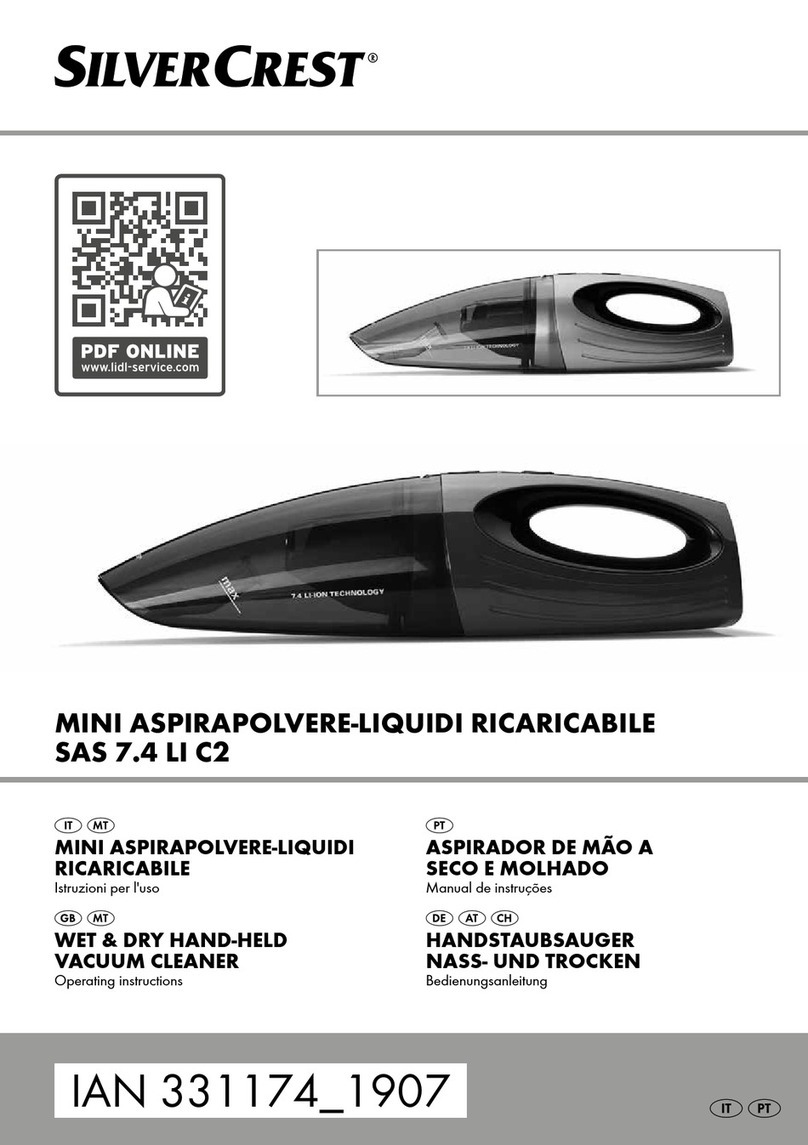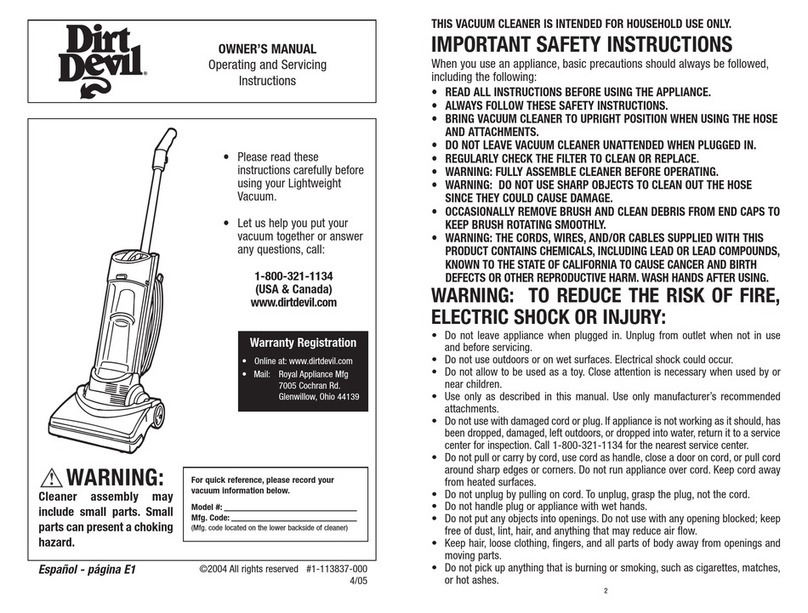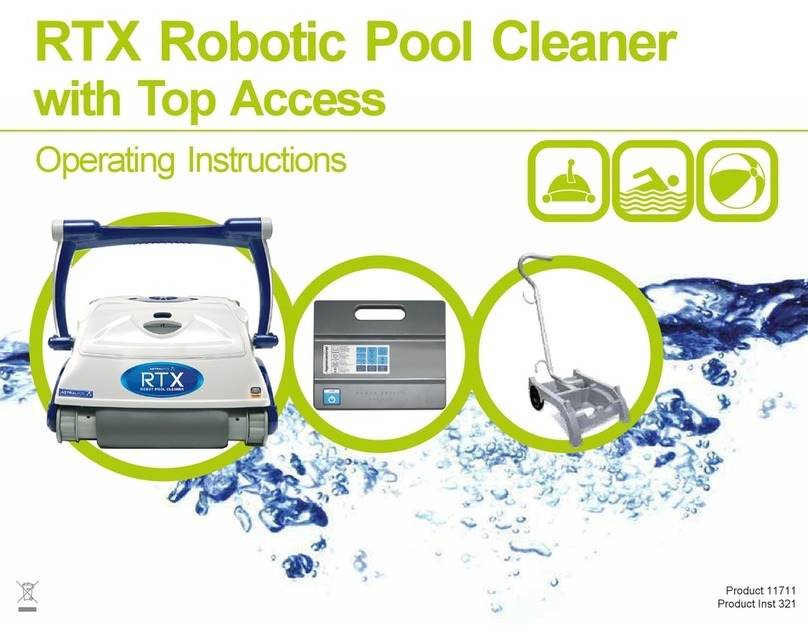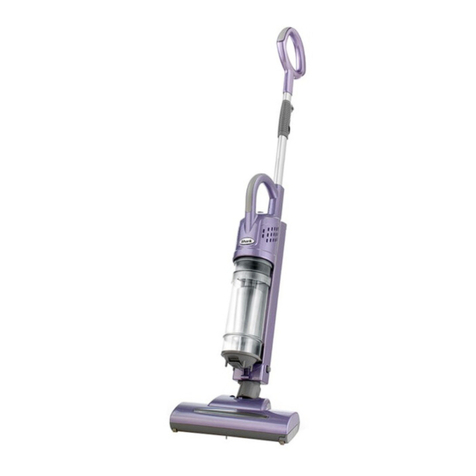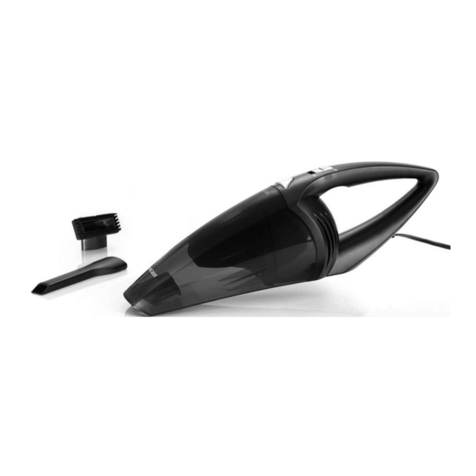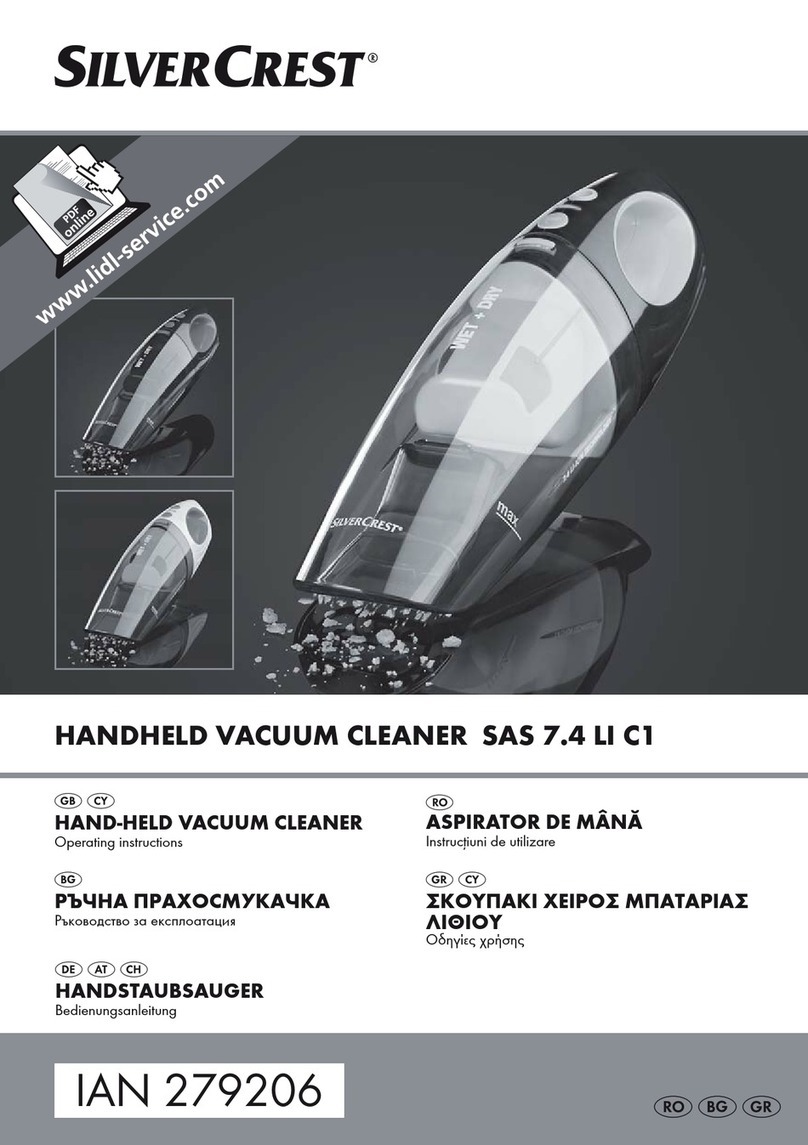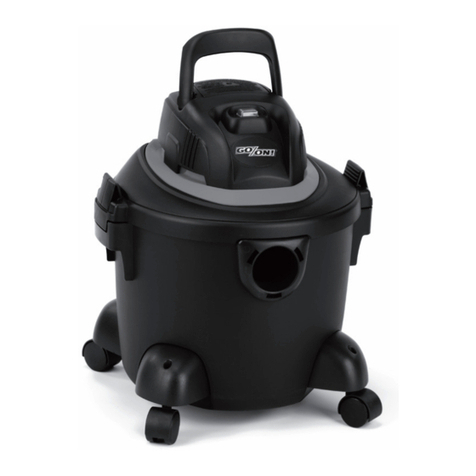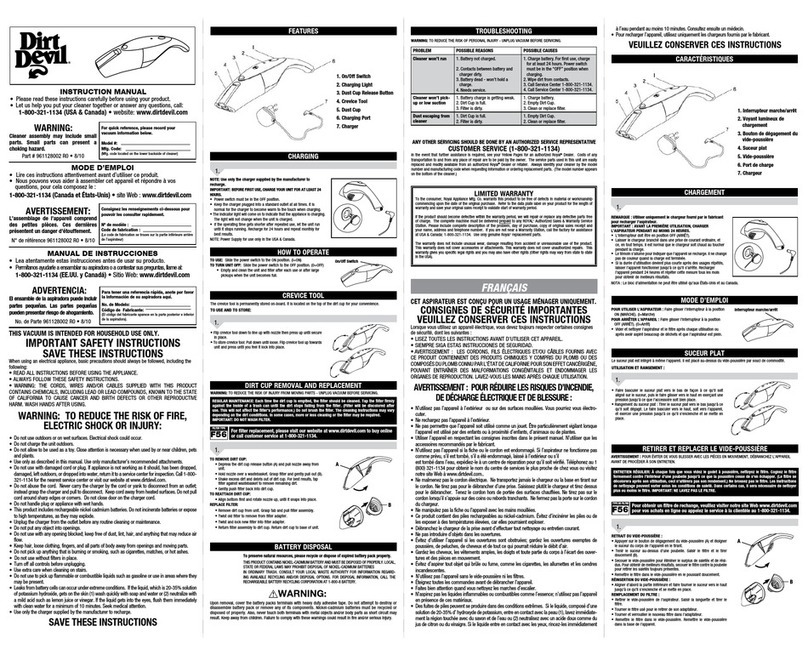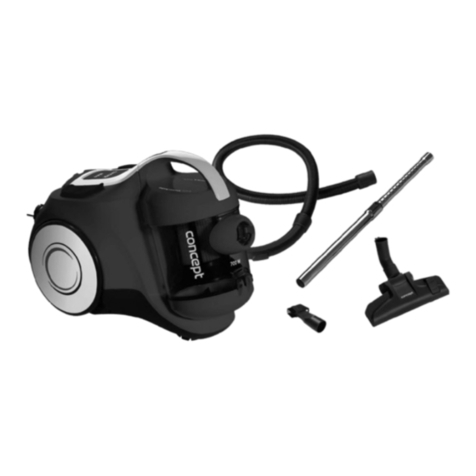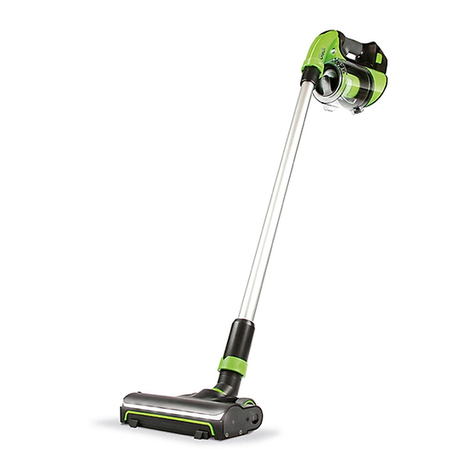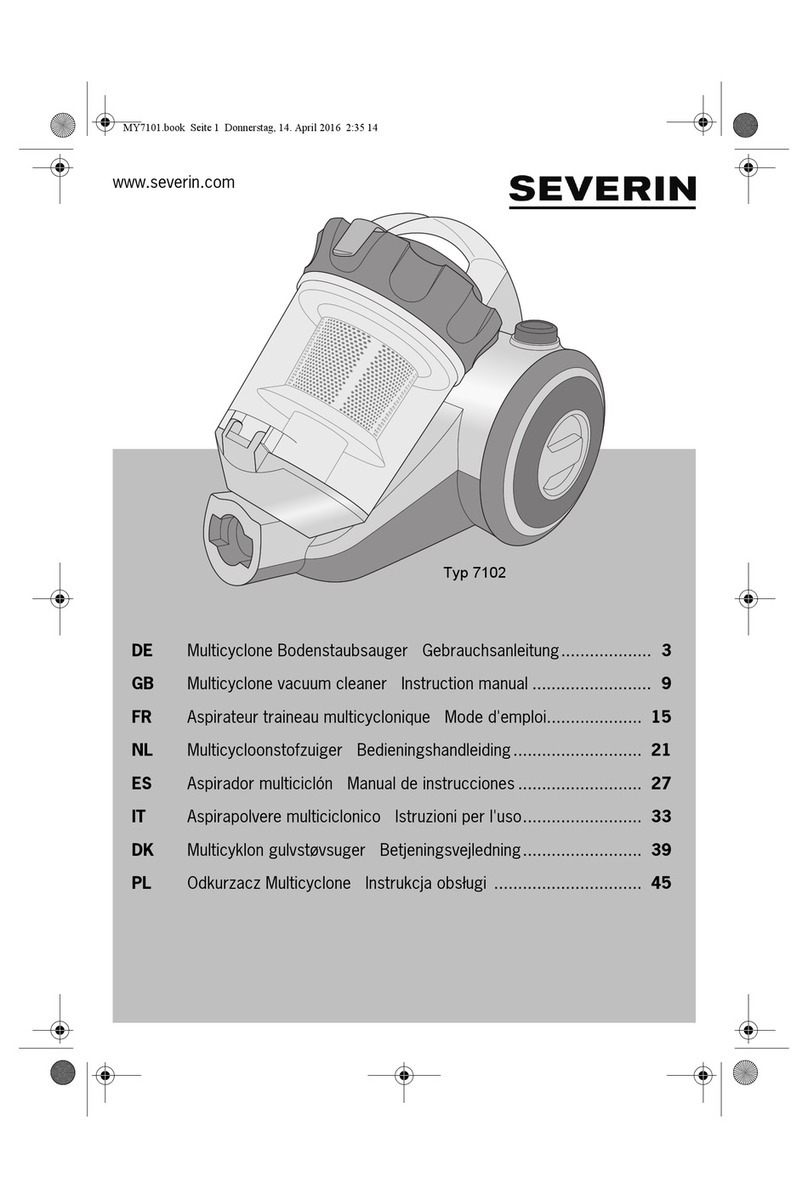Ryobi RDV36 User manual

RDV36
ORIGINAL INSTRUCTIONS
Cordless Garden
Vacuum

Important!
It is essential that you read the instructions in this manual before assembling,
operating, and maintaining the product.
Subject to technical modification.
Important!
It is essential that you read the instructions in this manual before assembling,
operating, and maintaining the product.
Subject to technical modification.

Safety, performance, and dependability have
been given top priority in the design of your
cordless garden vacuum.
INTENDED USE
The cordless garden vacuum is intended only
for outdoor use, in dry, and well-illuminated
conditions.
The product is designed for vacuuming light
debris, such as leaves, grass, and other
garden refuse. It is intended to vacuum and
mulch debris and deposit it into the collection
bag.
The product is not designed to suck in water
or other liquids.
Do not use the product for any other purpose.
GENERAL SAFETY WARNINGS
WARNING
Do not use the product to vacuum rocks,
reeds, soil, or sand.
If the product stops functioning, check the
following:
●The tube does not have an obstruction.
●The thumbscrew that attaches the
vacuum tube to the body is completely
tightened.
●The battery has charge.
WARNING
Read all safety warnings and all
instructions. Failure to follow the warnings
and instructions may result in electric shock,
re, and/or serious injury. Save all warnings
and instructions for future reference.
WARNING
This product is not intended for use by
persons (including children) with reduced
physical, sensory or mental capabilities,
or lack of experience and knowledge,
unless they have been given supervision or
instruction concerning the use of the product
by a person responsible for their safety.
Children should be supervised to ensure
that they do not play with the appliance.
TRAINING
■Read the instructions carefully. Be familiar
with the controls and the correct use of the
product.
■Keep in mind, that the operator or user
is responsible for accidents or hazards
occurring to other people or their property.
■Never use the product while tired, ill or
under the influence of alcohol, drugs, or
medication.
PREPARATION
■Some regions have regulations that restrict
the use of the product to some operations.
Check with your local authority for advice.
■Wear hearing protection at all times while
operating the product. Strictly adhere to
precautions to reduce noise to prevent
permanent hearing injury.
■Wear full eye protection at all times while
operating the product. Wear a full face
mask or fully enclosed goggles. Normal
spectacles or sunglasses are not adequate
protection. Objects can be thrown at high
speed by the powerful air jet at any time
and may rebound from hard surfaces
toward the operator.
■While operating the product, always wear
substantial footwear and long trousers.
Do not operate the product when barefoot
or wearing open sandals. Avoid wearing
clothing with loose fitting or that has
hanging cords or ties.
■Do not wear loose clothing or jewellery that
can be drawn into the air inlet. Secure long
hair so it is above shoulder level to prevent
entanglement in moving parts.
■Before each use, ensure that all controls
and safety devices function correctly. Do
not use the product if the off switch does
not stop the product.
■Operate the product in a recommended
position and only on a firm and level
surface.
■Do not operate the product on a paved
or gravel surface where ejected material
could cause injury.
■Before each use, always inspect the
housing for damage. Ensure that guards
and handles are in place and properly
secured. Replace worn or damaged
components in sets to preserve balance.
Replace damaged or unreadable labels.
1

■Never operate the product while people,
especially children, or pets are nearby.
■Keep all cooling air inlets clear of debris.
WARNING
Before using the product in vacuum mode,
you must assemble the upper and lower
vacuum tubes together. This is a one-time
operation only. Never operate the vacuum
with only the upper vacuum tube tted.
The risk of personal injury is signicantly
increased if you fail to follow this warning.
BATTERY TOOL USE AND CARE
■Recharge only with the charger specified
by the manufacturer. A charger that is
suitable for one type of battery pack may
create a risk of fire when used with another
battery pack.
■Use power tools only with specifically
designated battery packs. Use of any other
battery packs may create a risk of injury
and fire
■When battery pack is not in use, keep it away
from other metal objects, like paper clips,
coins, keys, nails, screws or other small
metal objects that can make a connection
from one terminal to another. Shorting the
battery pack terminals together may cause
burns or a fire.
■Under abusive conditions, liquid may
be ejected from the battery pack; avoid
contact. If contact accidentally occurs,
flush with water. If liquid contacts eyes,
additionally seek medical help. Liquid
ejected from the battery pack may cause
irritation or burns.
■Do not use a battery pack or tool that is
damaged or modified. Damaged or modified
batteries may exhibit unpredictable
behaviour resulting in fire, explosion, or
risk of injury.
■Do not expose a battery pack or tool to fire
or excessive temperatures. Exposure to
fire or excessive temperature above 130°C
may cause explosion.
■Follow all charging instructions and do not
charge the battery pack or tool outside
the temperature range specified in the
instructions. Charging improperly or at
temperatures outside the specified range
may damage the battery and increase the
risk of fire.
OPERATION
■Before starting the product, make sure that
the feeding chamber is empty.
■Keep your face and body away from the
feed intake opening.
■Operate the product only at reasonable
hours—not early in the morning or late at
night when people might be disturbed.
■Never operate the product in an explosive
atmosphere.
■Avoid using the product in bad weather
conditions especially when there is a risk
of lightning.
■Do not operate the product in poor lighting.
The operator requires a clear view of the
work area to identify potential hazards.
■Keep bystanders, children, and pets 15 m
away from the area of operation. Stop the
product if anyone enters the area.
■Operating similar tools nearby increases
both the risk of hearing injury and the
potential for other persons to enter your
working area.
■Always be sure of your footing on slopes.
Walk, never run.
■Do not allow hands or any other part of
the body or clothing inside the feeding
chamber, discharge chute, or near any
moving part.
■Keep proper footing and balance. Do not
overreach. Overreaching can result in loss
of balance.
■Never use the product with defective guards
or shields, or without safety devices, such
as debris collector, in place.
■Do not modify the product in any way or
use parts and accessories that are not
recommended by the manufacturer.
WARNING
If the product is dropped, suffers heavy
impact, or begins to vibrate abnormally,
immediately stop the product and inspect
for damage or identify the cause of the
vibration. Any damage should be properly
repaired or replaced by an authorised
service centre.
2

■To reduce the risk of injury associated with
contacting rotating parts, always turn off
the product and remove the battery pack.
Make sure that all moving parts have come
to a complete stop:
–before leaving the product unattended
–before clearing blockages or unclogging
chute
–before checking, cleaning, or working on
the product
–before inspecting the product after
striking a foreign object
–whenever the product starts to vibrate
abnormally (inspect immediately)
■Immediately turn off the product and
remove the battery pack in the event of
accident or breakdown. Do not operate
the product again until it has been fully
checked by an authorised service centre.
WARNING
Your vacuum may be supplied with a
harness. Carefully adjust the harness to
comfortably help to support the weight
of the product. Identify the quick release
mechanism and practice using it before
you start using the product. Its correct use
may prevent serious injury in the case of an
emergency. Never wear additional clothing
over the harness or otherwise restrict
access to the quick release mechanism.
VACUUM SAFETY WARNINGS
WARNING
Never operate the vacuum with only the
upper vacuum tube tted. Failure to follow
this warning increases the risk of personal
injury.
Note: Without the lower vacuum tube tted,
it is much easier to reach up inside the tube
towards the fan blade.
■Do not operate the vacuum without the
debris collector bag assembly installed.
Flying debris could cause serious injury.
Make sure that the debris collector bag is
in good condition and completely closed
before operating the product.
■Move the vacuum from side to side along
the outer edge of the debris. To avoid
clogging, do not place the vacuum tube
directly into the debris pile.
■Hold the motor higher than the inlet end of
the vacuum tube.
■To avoid serious injury to the operator
or damage to the product, do not try to
vacuum up rocks, broken glass, bottles, or
similar objects.
■Avoid situations that could cause fire in
the debris collector bag. Do not operate
the product near an open flame. Do not
vacuum up warm ash from fireplaces and
barbecue pits. Do not vacuum up discarded
cigars or cigarettes unless the cinders are
completely cool.
■Keep all parts of your body away from
any moving part. Rotating impeller blades
can cause severe injury. Stop the product
and ensure impeller blades have stopped
rotating before removing the tubes, opening
or removing debris bag.
■When feeding material into the product,
make sure that the pieces of metal, rocks,
bottles, cans, or other foreign objects are
not included.
■Do not allow processed material to build
up in the discharge zone. This may prevent
proper discharge and can result in kickback
of material through the intake opening.
■If the product becomes clogged, stop
the product and remove the battery pack
before cleaning the debris.
ADDITIONAL BATTERY SAFETY
WARNINGS
WARNING
To reduce the risk of re, personal injury,
and product damage due to a short circuit,
never immerse your tool, battery pack or
charger in uid or allow a uid to ow inside
them. Corrosive or conductive uids, such
as seawater, certain industrial chemicals,
and bleach or bleach-containing products,
etc., can cause a short circuit.
TRANSPORTATION AND STORAGE
■Stop the product, remove the battery pack,
and allow it to cool down before storing or
transporting.
■Clean all foreign materials from the product.
Store the product in a cool, dry, and well-
3

ventilated place that is inaccessible
to children. Keep the product away
from corrosive agents, such as garden
chemicals and de-icing salts. Do not store
the product outdoors.
■For transportation in a vehicle, secure the
product against movement or falling to
prevent injury to persons or damage to the
product.
TRANSPORTING LITHIUM BATTERIES
Transport the battery pack in accordance with
local and national provisions and regulations.
Follow all special requirements on packaging
and labelling when transporting batteries by a
third party. Ensure that no batteries can come
in contact with other batteries or conductive
materials while in transport by protecting
exposed connectors with insulating, non-
conductive caps or tape. Do not transport
battery packs that are cracked or leaking.
Check with the forwarding company for further
advice.
MAINTENANCE
WARNING
Use only original manufacturer’s
replacement parts, accessories, and
attachments. Failure to do so can cause
possible injury, can contribute to poor
performance, and may void your warranty.
WARNING
Servicing requires extreme care and
knowledge and should be performed only by
a qualied service technician. For service,
have the product serviced by an authorised
service centre only. When servicing, use
only identical replacement parts.
■Do not make adjustments and repairs not
described in this manual. For other repairs,
contact an authorised service centre.
■After each use, clean the product with a
soft, dry cloth.
■Check all nuts, bolts, and screws at
frequent intervals for proper tightness to
ensure that the product is in safe working
condition. Any part that is damaged should
be properly repaired or replaced by an
authorised service centre.
■Bring the product to an authorised service
centre to replace damaged or unreadable
labels.
CLEARING A BLOCKAGE
■To reduce the risk of injury associated with
contacting rotating parts, always turn off
the product, remove the battery pack, and
make sure that all moving parts have come
to a complete stop.
■Remove the tubes to inspect for blockage.
Clear the tubes if required.
■Remove the debris collector bag. Check
that the bag adaptor is free from obstruction.
■Inspect the opening to the fan enclosure
and the tube to the debris bag for evidence
of a blockage. Remember, even though
the battery pack is removed, the fan or
mulching blades may move as you clear
any blockage. Keep fingers away from the
fan or mulching blades at all times.
■Do not attempt to remove the fan or
mulching blade. If it is necessary to remove
the fan or mulching blades, bring the
product to an authorised service centre.
■Reinstall the tubes and the debris collector
bag before installing the battery pack and
starting the product.
RESIDUAL RISKS
Even when the product is used as prescribed,
it is still impossible to completely eliminate
certain residual risk factors. The following
hazards may arise during use, and the
operator should pay special attention to avoid
the following:
■injury caused by vibration
–Always use the right tool for the job, hold
the product by the designated handles
and use the lowest speed necessary to
achieve the task.
■injury caused by exposure to noise
–Wear ear protection and limit exposure.
■injury caused by flying objects from the
tube airflow
–Wear eye protection at all times.
4

RISK REDUCTION
It has been reported that vibrations from
handheld tools may contribute to a condition
called Raynaud’s Syndrome. Symptoms may
include tingling, numbness, and blanching of
the ngers, usually apparent upon exposure
to cold. Hereditary factors, exposure to cold
and dampness, diet, smoking, and work
practices are all thought to contribute to the
development of these symptoms. There are
measures that can be taken by the operator to
possibly reduce the effects of vibration:
■Keep your body warm in cold weather.
When operating the product, wear gloves
to keep the hands and wrists warm. It is
reported that cold weather is a major factor
contributing to Raynaud’s Syndrome.
■After each period of operation, exercise to
increase blood circulation.
■Take frequent work breaks. Limit the
amount of exposure per day.
If you experience any of the symptoms of this
condition, immediately discontinue use and
see your physician.
WARNING
Injuries may be caused or aggravated by
prolonged use of the product. When using
any tool for prolonged periods, ensure to
take regular breaks.
WHAT’S IN THE BOX
■Leaf vacuum housing x 1
■Upper vacuum tube x 1
■Lower vacuum tube x 1
■Guide wheels x 1
■Leaf collection bag x 1
■Harness
■Manual x 1
SYMBOLS ON THE PRODUCT
Read and understand
all instructions before
operating the product. Follow
all warnings and safety
instructions.
Beware of thrown or ying
objects. Keep all bystanders,
especially children, and pets,
at least 15 m away from the
operating area.
Rotating fans. Keep hands
and feet out of openings while
the product is running.
Wear ear protection.
Wear eye protection.
Do not expose the product to
rain or damp conditions.
Remove the battery pack
before starting any work on
the product.
1
0
4
Guaranteed sound power
level
Regulatory Compliance
Mark (RCM). This product
meets applicable regulatory
requirements.
Waste electrical products
should not be disposed of
with household waste. Please
recycle where facilities exist.
Check with your local authority
or retailer for recycling advice.
5

6
SYMBOLS IN THIS MANUAL
Note
Warning
Parts or accessories are sold
separately
The following signal words and meanings
are intended to explain the levels of risk
associated with this product.
DANGER
Indicates an imminently hazardous
situation, which, if not avoided, will result in
death or serious injury.
WARNING
Indicates a potentially hazardous situation,
which, if not avoided, could result in death
or serious injury.
CAUTION
Indicates a potentially hazardous situation,
which, if not avoided, may result in minor or
moderate injury.
CAUTION
Without safety alert symbol
Indicates a situation that may result in
property damage.

7

8
WHAT’S IN THE BOX
x 1
x 1
x 1
x 1
x 1
x 1
x 1
RDV36
* Battery and charger are sold separately.

9
Know your product
KNOW YOUR PRODUCT
21 3 4 5
6
7
8
9
10
11
12
1. Locking pin
2. Quick release harness
3. Variable speed switch
4. On/Off trigger
5. Handle
6. Bag adaptor
7. Vacuum bag
8. Guide wheels
9. Lower vacuum tube
10. Upper vacuum tube
11. Thumbscrew
12. Front handle

GETTING STARTED
1 2
Wear full eye and ear protection, substantial footwear, and
long trousers at all times while operating the product. Do
not operate the product when barefoot or wearing open
sandals.
Slide the guide wheels onto the lower vacuum tube.
NOTE: Use the tab on the rear side to slide the guide
wheels and adjust its position.
10
Hook the front side of the leaf collection bag to the upper
tube, and then slide the vacuum bag opening over the
housing elbow until it snaps into place.
2
3
1
1
2
78
Hook the harness to the front handle.

GETTING STARTEDGETTING STARTED GETTING STARTED
2
1
3 4
9
6
11
LOW HIGH
5
11
10
Install the vacuum tube assembly into the housing.
NOTE: Make sure that the locking pin is inserted into the upper tube, locking the tube assembly in place.
Set the speed switch to the preferred speed.
NOTE: The speed can be set to LOW or HIGH.
Insert the lower vacuum tube into the upper vacuum tube
until it snaps in place.
12
Pull the locking pin. Turn the thumbscrew clockwise until it snaps in place and
is fully tightened.
The product will not start if the thumbscrew is not fully
tightened.
Hold the product by the designated handles and operate
the product in the recommended position as shown. The
wheels work best when used on a at surface such as a
concrete patio or sidewalk.
WARNING: Never operate the vacuum with only the
upper vacuum tube tted. Failure to follow this warning
increases the risk of personal injury.
Pull the quick release tab to easily remove the harness
from the product.
Install the battery pack. Squeeze the trigger to start the product.

12

OVERVIEW
13
Using the vacuum Cleaning the vacuum
Emptying the vacuum Storing the vacuum
p.14 p.18
p.19p.17

OPERATION
14
Vacuum setup
1
1
2
2
3
4
USING THE VACUUM
1. Slide the guide wheels under the lower
vacuum tube.
NOTE: Use the tab on the rear side to
slide the guide wheels and adjust its
position.
2. Insert the lower vacuum tube into the
upper vacuum tube until it snaps in
place.
3. Pull the locking pin, and insert the tube
assembly into the housing.
NOTE: Make sure that the locking pin is
inserted into the upper tube, locking the
tube assembly in place.
4. Turn the thumbscrew clockwise until it
snaps in place and is fully tightened.
NOTE: The product will not start if the
thumbscrew is not fully tightened.
WARNING: Never operate the
vacuum with only the upper vacuum
tube tted. Failure to follow this warning
increases the risk of personal injury.

OPERATION
15
LOW HIGH
8
1
3
2
12
5
6
7
5. Hook the front side of the leaf collection
bag to the upper tube, then slide the bag
opening over the housing elbow until it
snaps in place.
6. Hook the harness to the front handle.
7. Insert the batttery into the housing.
Squeeze the trigger to start the product.
8. Flip the variable speed switch to the
LOW position to set the vacuum at low
speed. Flip the variable speed switch to
the HIGH position to set the vacuum at
high speed.

OPERATION
16
9
WARNING: Always hold the product with
both hands at the designated handles.
9. Squeeze the trigger to start the product.
NOTE: Operate the product in the
recommended position. The wheels work
best when used on a at surface such as a
concrete patio or sidewalk.

OPERATION
17
Emptying the vac bag
1
2
1
2
4
3
1
2
3
EMPTYING THE VACUUM
1. Remove the battery pack.
2. Unhook the leaf collection bag from the
upper vacuum tube, then unlatch the
bag from the housing.
3. Open the vacuum bag.
4. Remove the contents of the leaf
collection bag into a suitable container.

MAINTENANCE
18
1
2
1
2
CLEANING THE VACUUM
1. Remove the battery pack.
2. Clean the product using a brush.
WARNING: Avoid using solvents when
cleaning plastic parts. Most plastics are
susceptible to damage from various types of
commercial solvents and may be damaged
by their use.
This manual suits for next models
1
Table of contents
Other Ryobi Vacuum Cleaner manuals

Ryobi
Ryobi R18HV User manual
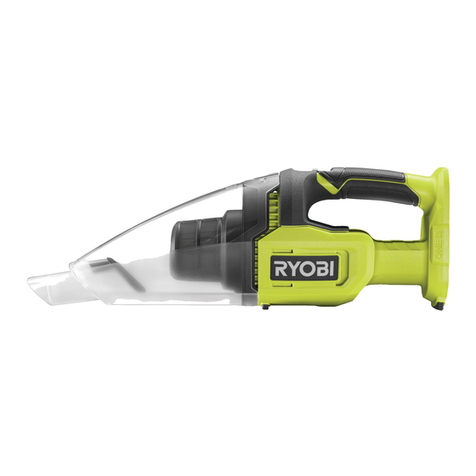
Ryobi
Ryobi RHV18 User manual
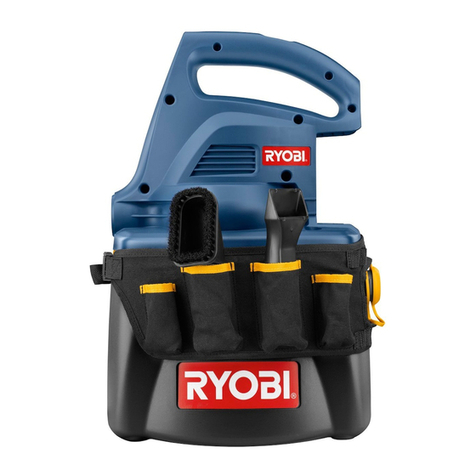
Ryobi
Ryobi P3200 Quick setup guide

Ryobi
Ryobi RVC-1220I-G Operation manual
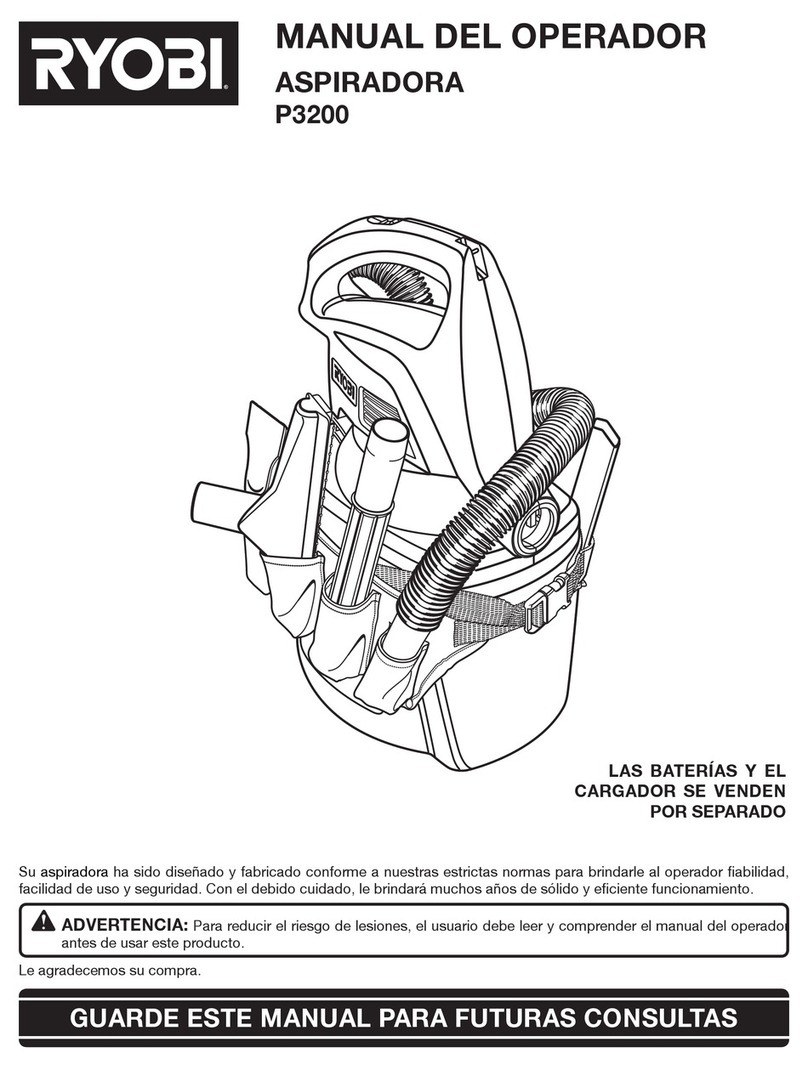
Ryobi
Ryobi P3200 User guide
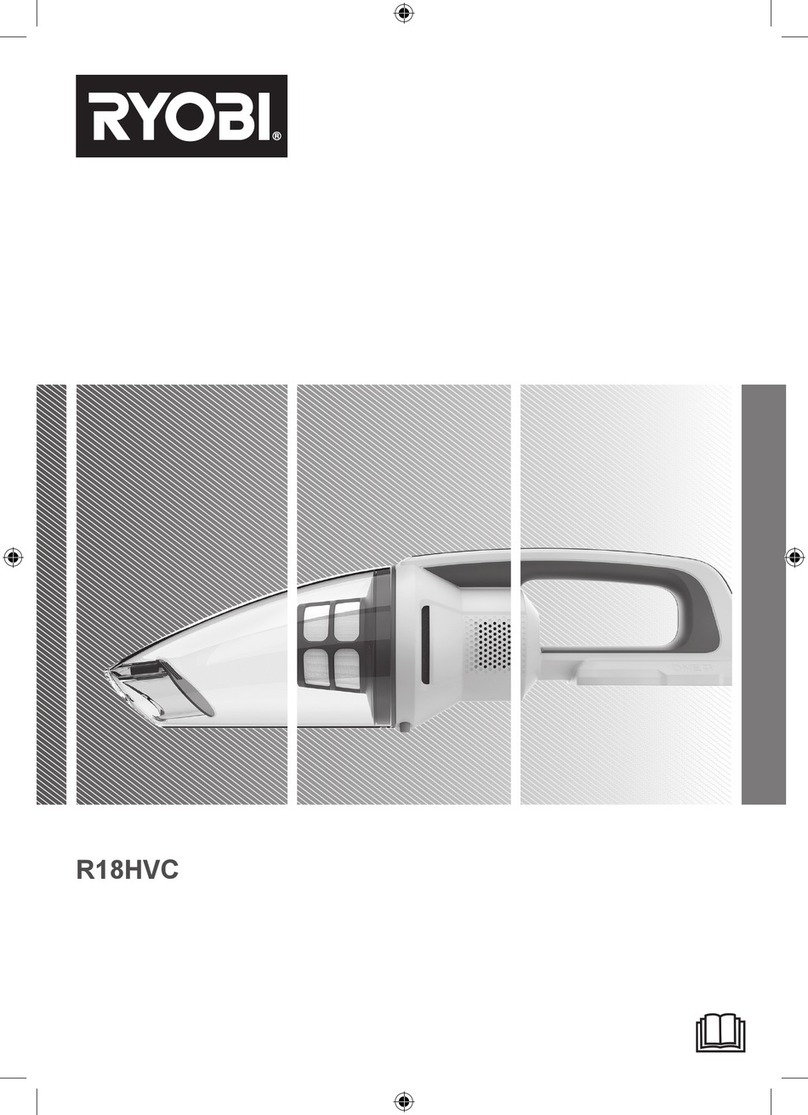
Ryobi
Ryobi R18HVC User manual

Ryobi
Ryobi PCL705 User manual
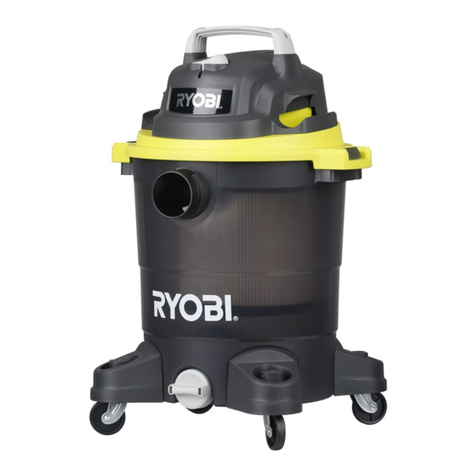
Ryobi
Ryobi RVC-1420C-G Operation manual
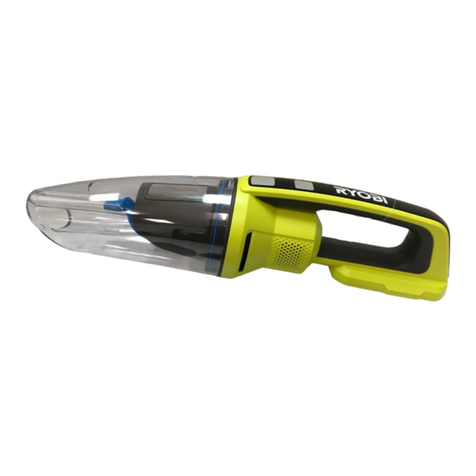
Ryobi
Ryobi PCL702 User manual

Ryobi
Ryobi VC20HD Operation manual
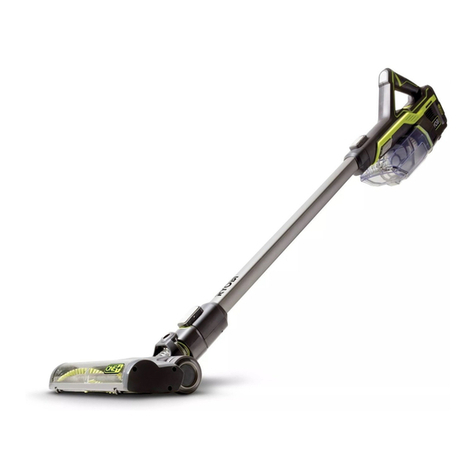
Ryobi
Ryobi R18SV7 User manual
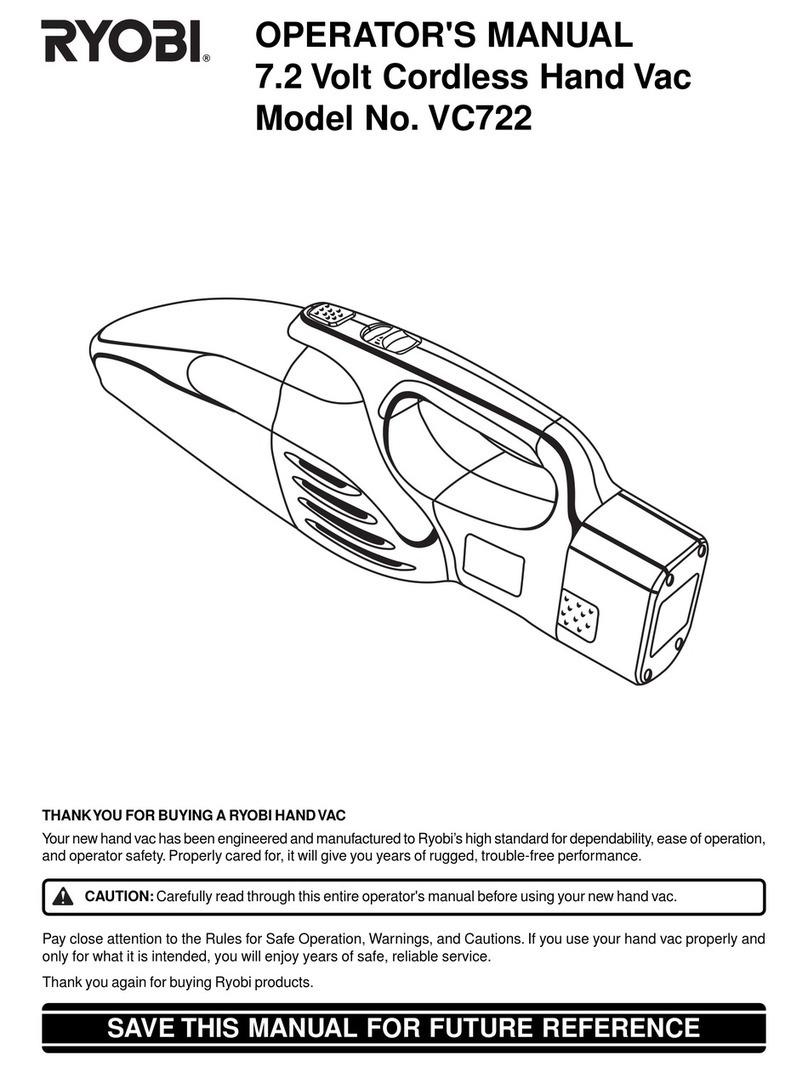
Ryobi
Ryobi VC722 User manual

Ryobi
Ryobi R18SV8 User manual

Ryobi
Ryobi P719 User manual
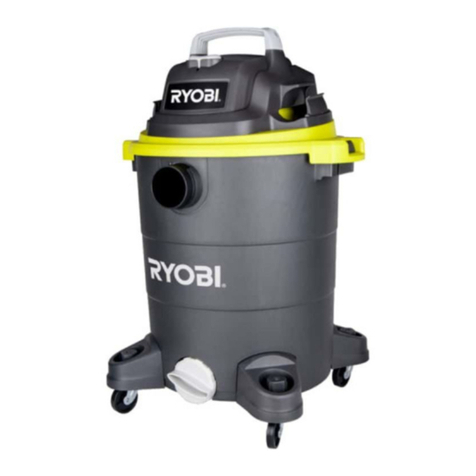
Ryobi
Ryobi RVC-1430PPT-G Operation manual

Ryobi
Ryobi RVC-1430PPT-G Operation manual
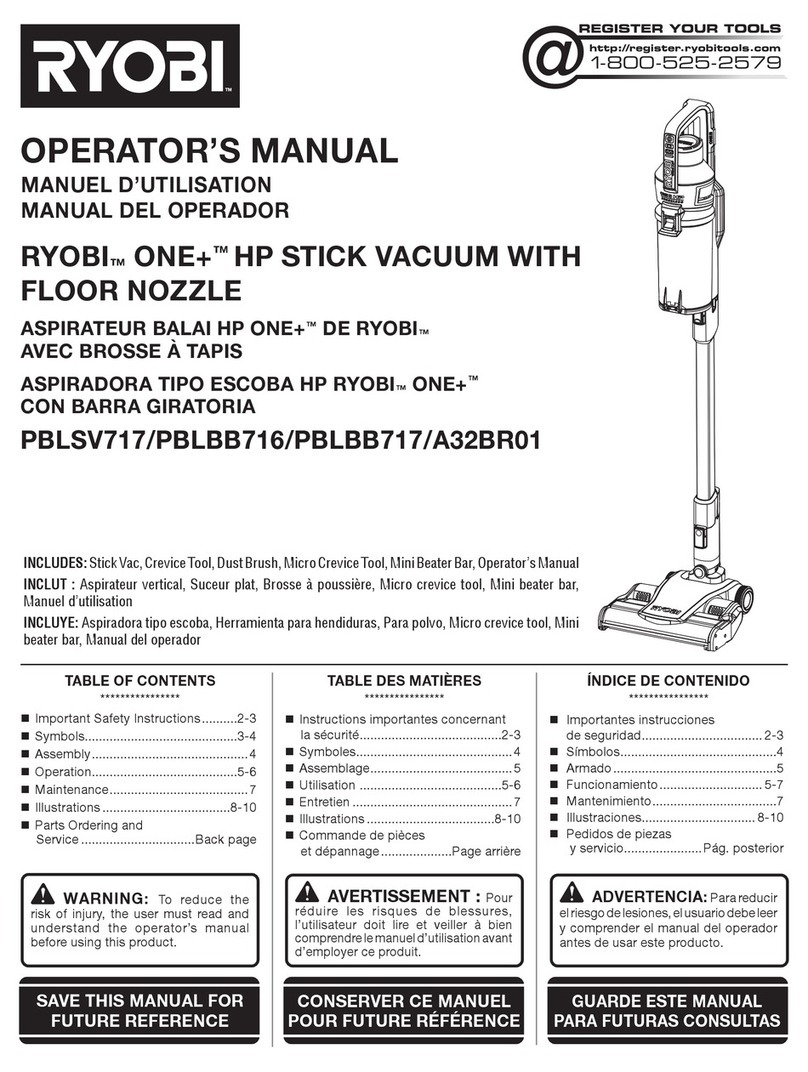
Ryobi
Ryobi ONE+ PBLSV717 User manual
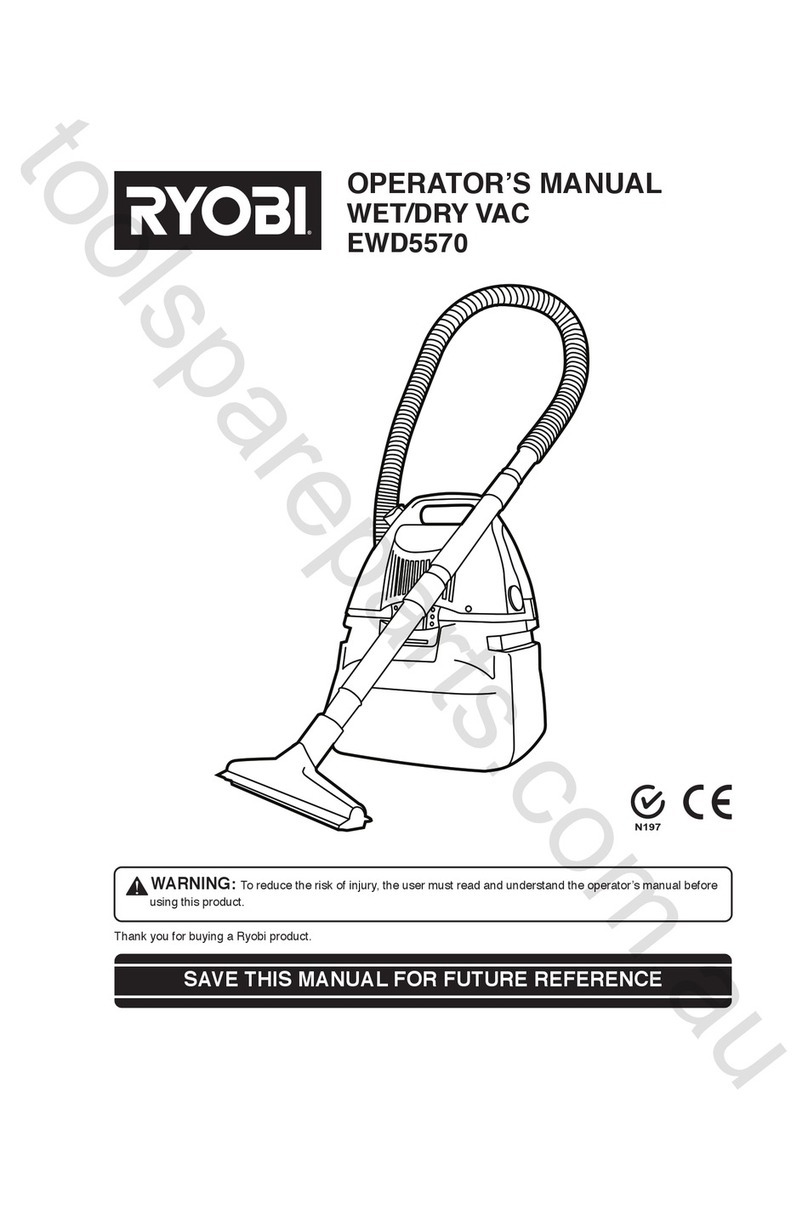
Ryobi
Ryobi EWD5570 User manual
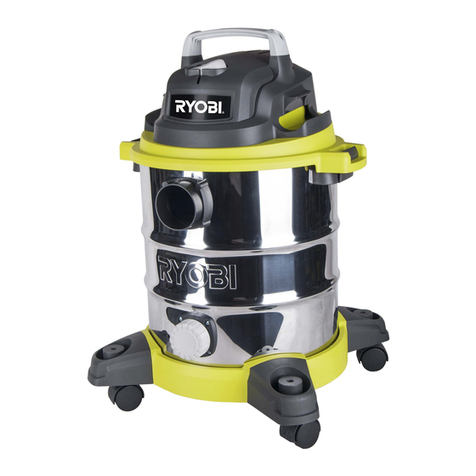
Ryobi
Ryobi RVC-1220I-G User manual

Ryobi
Ryobi ONE+ P7181 User manual




